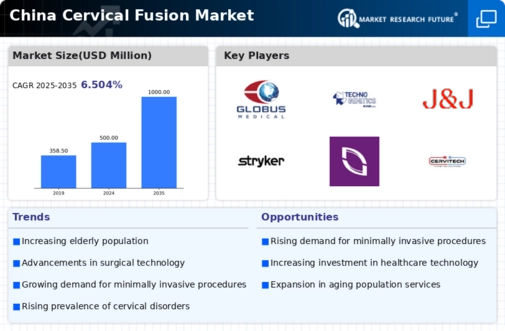Supportive Reimbursement Policies
Supportive reimbursement policies in China are playing a pivotal role in driving the cervical fusion market. The government has been implementing reforms to improve insurance coverage for surgical procedures, including cervical fusion. As of 2025, it is estimated that approximately 80% of cervical fusion surgeries are now covered by public health insurance, making these procedures more accessible to patients. This increased financial support encourages more individuals to opt for surgical interventions rather than conservative treatments. Furthermore, the alignment of reimbursement policies with clinical guidelines ensures that healthcare providers are incentivized to offer cervical fusion procedures. As a result, the cervical fusion market is expected to expand, driven by the growing number of patients who can afford these essential surgical treatments.
Rising Incidence of Spinal Disorders
The increasing prevalence of spinal disorders in China is a critical driver for the cervical fusion market. Conditions such as herniated discs and degenerative disc disease are becoming more common, leading to a higher demand for surgical interventions. According to recent estimates, spinal disorders affect approximately 30% of the population in urban areas, which translates to millions of potential patients. This growing patient base necessitates advanced surgical solutions, thereby propelling the cervical fusion market forward. Furthermore, the healthcare system's focus on improving surgical outcomes and reducing recovery times aligns with the adoption of innovative cervical fusion techniques. As a result, the market is likely to experience substantial growth, driven by the need to address these prevalent spinal issues effectively.
Growing Awareness of Surgical Options
The rising awareness among patients regarding surgical options for spinal issues is a significant driver for the cervical fusion market. Educational campaigns and increased access to information have empowered patients to seek surgical interventions for conditions that were previously managed conservatively. Surveys indicate that over 60% of patients are now aware of cervical fusion as a viable treatment option. This shift in patient perception is encouraging more individuals to consult healthcare professionals about their spinal health. As a result, the demand for cervical fusion procedures is likely to rise, prompting healthcare providers to expand their offerings in the cervical fusion market. This trend suggests a potential increase in surgical volumes and a corresponding growth in market revenues.
Investment in Healthcare Infrastructure
China's ongoing investment in healthcare infrastructure significantly impacts the cervical fusion market. The government has been allocating substantial funds to enhance medical facilities, particularly in urban regions. This investment includes the establishment of specialized spine centers equipped with advanced surgical technologies. As of 2025, it is estimated that healthcare spending in China will reach approximately $1 trillion, with a notable portion directed towards orthopedic services. This expansion not only increases the availability of cervical fusion procedures but also improves patient access to quality care. Consequently, the cervical fusion market is poised for growth as more hospitals adopt state-of-the-art technologies and techniques, ultimately leading to better patient outcomes and satisfaction.
Technological Innovations in Surgical Techniques
Technological innovations in surgical techniques are transforming the cervical fusion market in China. The introduction of minimally invasive surgical methods and advanced imaging technologies has enhanced the precision and safety of cervical fusion procedures. Techniques such as endoscopic surgery and robotic-assisted surgery are gaining traction, offering patients reduced recovery times and improved outcomes. As of 2025, it is projected that the market for minimally invasive spine surgery will grow at a CAGR of over 15%. This trend indicates a shift towards more sophisticated surgical options, which could lead to an increase in the number of cervical fusion surgeries performed. Consequently, the cervical fusion market is likely to benefit from these advancements, as healthcare providers adopt new technologies to meet patient demands.




















Leave a Comment